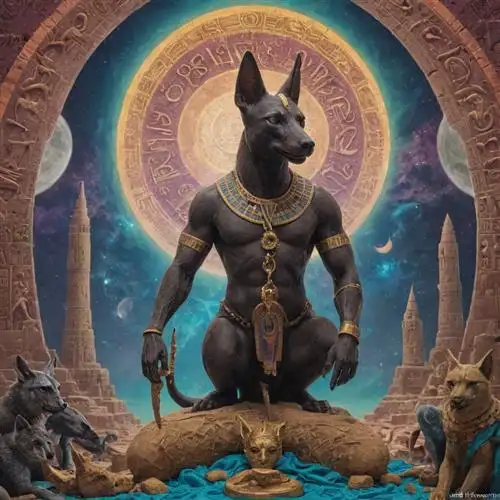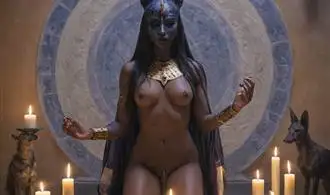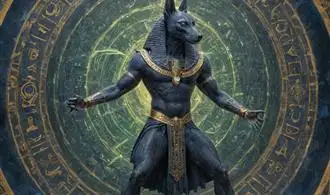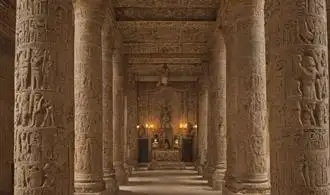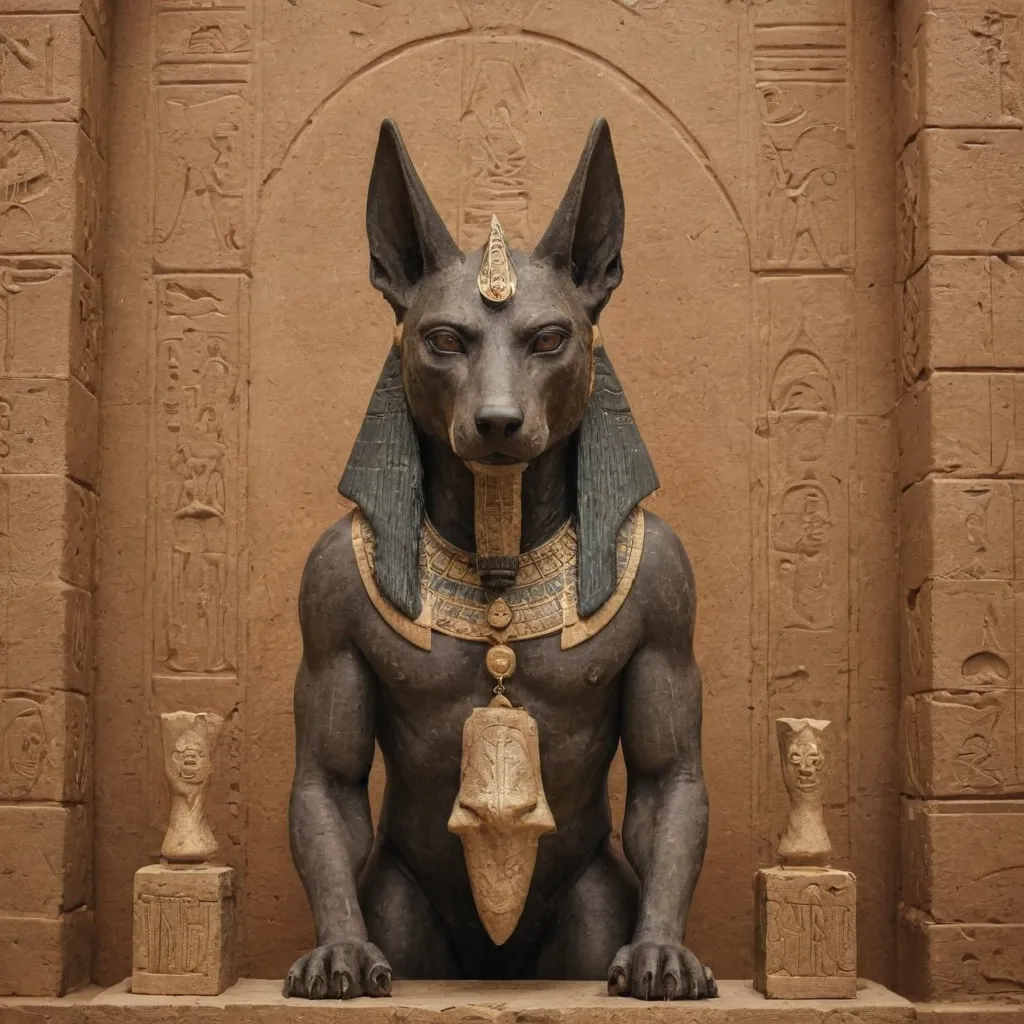
The Jackal Headed God Anubis
Anubis, the enigmatic jackal-headed deity, has long held a captivating presence within the rich tapestry of ancient Egyptian mythology. This enigmatic figure, often depicted with the head of a jackal, was revered as the god of mummification and the afterlife, guiding the deceased on their journey through the realms of the dead.
The symbolism of Anubis is deeply rooted in the ancient Egyptians' beliefs and practices surrounding death and the afterlife. As the guardian of the dead, Anubis was responsible for the preparation of the body for the journey to the afterlife, a process that involved the intricate art of mummification. This role was crucial, as the Egyptians believed that the preservation of the physical form was essential for the soul's continued existence in the afterlife.
The jackal-headed form of Anubis is believed to have been chosen for its symbolic significance. Jackals were often associated with the necropolis, the ancient Egyptian burial grounds, as they were scavengers that frequented these sacred spaces. The jackal's keen sense of smell and ability to navigate the darkness of the underworld made it an apt representation of Anubis, who was tasked with guiding the dead through the treacherous journey to the afterlife.
In addition to his role as the god of mummification, Anubis was also responsible for weighing the hearts of the deceased against the feather of truth, a critical step in the ancient Egyptian concept of the afterlife. This process, known as the "Weighing of the Heart," determined whether the soul of the deceased was worthy of entering the afterlife. Anubis oversaw this momentous occasion, ensuring the preservation of justice and the balance of the afterlife.
The cult of Anubis was widespread throughout ancient Egypt, with temples and shrines dedicated to the deity found across the land. These sacred spaces served as centers of worship, where the faithful could seek the guidance and protection of Anubis in their journey through life and into the afterlife. The importance of Anubis in the Egyptian pantheon is further underscored by his inclusion in the renowned "Book of the Dead," a collection of spells and rituals that were believed to aid the deceased in their passage to the afterlife.
Symbolic Associations of Anubis
Anubis, the ancient Egyptian god with the head of a jackal, is a complex and multifaceted deity whose symbolism extends far beyond his role as the god of the dead. His associations with various aspects of Egyptian mythology and cosmology offer a rich tapestry of meaning for those seeking to deepen their understanding of this enigmatic figure.
One of the primary symbolic associations of Anubis is his role as the guardian of the necropolis, the ancient Egyptian city of the dead. As the god responsible for the embalming and mummification process, Anubis was seen as the intermediary between the world of the living and the realm of the dead. His presence at the moment of death and his guidance through the afterlife were essential for the successful transition of the deceased into the next world.
Furthermore, Anubis was closely linked to the concept of the weighing of the heart, a crucial ritual in the judgment of the dead. During this ceremony, the deceased's heart was weighed against the feather of Ma'at, the goddess of truth and justice. Anubis was responsible for overseeing this process, ensuring the fairness and accuracy of the judgment, and guiding the soul of the deceased to their final resting place.
Beyond his role in the afterlife, Anubis was also associated with various other symbolic meanings. As a jackal-headed deity, he was believed to have a keen sense of smell and the ability to navigate the darkness, making him a symbol of protection and guidance. This association with the jackal, a scavenger that was often seen near tombs and burial sites, further strengthened Anubis's connection to the realm of the dead and the transition between life and death.
Additionally, Anubis was sometimes depicted as a protector of the living, guarding against the dangers and uncertainties of the world. His role as a guardian deity extended to the protection of the pharaoh and other important figures, as well as the safeguarding of sacred spaces and rituals.
In the broader context of Egyptian mythology, Anubis's symbolism was intertwined with the concept of regeneration and the cyclical nature of existence. As the god responsible for the embalming and preservation of the dead, he was seen as a symbolic link between the realms of the living and the dead, facilitating the continuity of life and the eternal cycle of rebirth.
Anubis and the Afterlife
The ancient Egyptian deity Anubis, known as the "Lord of the Dead," played a crucial role in the journey of the deceased through the afterlife. As the god of embalming and funerary rites, Anubis was responsible for guiding the souls of the dead to the next phase of their existence, ensuring a smooth transition and a favorable judgment before the divine tribunal.
One of the primary responsibilities of Anubis was the mummification process. He was believed to have taught the art of embalming to the ancient Egyptians, allowing for the preservation of the physical body. This was an essential step in the afterlife journey, as the Egyptians believed the soul could only return to the body if it remained intact.
During the funerary rites, Anubis would carefully oversee the mummification and the weighing of the heart ceremony, known as the "Judgment of the Dead." In this ritual, the deceased's heart was weighed against the feather of Ma'at, the goddess of truth and justice. If the heart was found to be pure and just, the soul would be allowed to pass into the afterlife. If the heart was found to be heavy with sin, the soul would be condemned to eternal damnation.
Anubis's role as the guide of the dead extended beyond the judgment process. He was believed to escort the deceased to the underworld, known as the "Field of Reeds," where they would be reunited with their loved ones and live a peaceful and prosperous afterlife. Additionally, Anubis was responsible for protecting the tomb and ensuring the safety of the mummified body, allowing the soul to return to its physical form when necessary.
The symbolism of Anubis in the afterlife was not limited to his duties as a funerary god. He was also associated with the jackal, a creature that was believed to have the ability to navigate the boundary between the world of the living and the dead. This connection to the jackal further reinforced Anubis's role as a guide and protector of the deceased.
Anubis in Ancient Egyptian Mythology
Anubis, the jackal-headed god, holds a prominent place in the rich tapestry of ancient Egyptian mythology. As the god of the dead, embalming, and the afterlife, Anubis played a crucial role in the Egyptian belief system and the intricacies of their funerary practices. To gain a deeper understanding of this powerful deity, it is essential to delve into the symbolic significance of Anubis in ancient Egyptian mythology.
In the Egyptian pantheon, Anubis was responsible for guiding the deceased through the perilous journey to the afterlife. As the protector of the dead, he oversaw the embalming process, ensuring the proper preparation of the body for its eternal rest. The jackal-headed form of Anubis was carefully chosen, as the jackal was believed to be a mystical creature that could traverse the boundary between the world of the living and the realm of the dead.
Anubis's role in the Egyptian afterlife was crucial. He was tasked with weighing the heart of the deceased against the feather of truth, a symbolic act that determined the individual's worthiness to proceed to the next life. This ceremony, known as the "Weighing of the Heart," was a pivotal moment in the journey of the soul, and Anubis's presence ensured the fairness and accuracy of this judgment.
Beyond his role in the afterlife, Anubis was also associated with other important aspects of ancient Egyptian culture. He was believed to have the power to protect the living from the dangers of the underworld and was often invoked to provide guidance and protection during funerary rituals. Additionally, Anubis was revered as a patron of embalmers, ensuring the proper preservation of the deceased and their successful transition to the afterlife.
The symbolism of Anubis extended beyond his physical form and specific duties. The jackal, as the animal sacred to this deity, held deep significance in ancient Egyptian beliefs. Jackals were often seen as scavengers that could navigate the boundary between life and death, making them the perfect embodiment of Anubis's role as the guide of the dead.
Furthermore, the color black, which was associated with Anubis, held profound symbolic meaning. Black was seen as the color of the fertile soil of the Nile River, symbolizing rebirth, renewal, and the cyclical nature of life and death. Anubis's black color, then, represented his role in the cycle of existence, as he ushered the deceased into the afterlife and prepared them for their eventual return to the world of the living.
The Iconography of Anubis
The Iconography of Anubis, the jackal-headed deity of ancient Egyptian mythology, is a rich tapestry of symbolism and visual representation. As one of the most prominent figures in the Egyptian pantheon, Anubis' iconography has evolved over centuries, reflecting the profound significance of this enigmatic figure.
At the core of Anubis' iconography is the jackal, a revered animal in ancient Egyptian culture. The jackal's association with death and the underworld made it an apt choice to represent Anubis, the god responsible for the mummification process and the protection of the dead. The jackal's keen senses and ability to navigate the liminal spaces between the living and the dead further solidified its symbolic connection to Anubis.
In visual representations, Anubis is often depicted with a jackal's head, sometimes with a distinctly canine snout, pointed ears, and a sleek, muscular body. This iconic form serves as a powerful visual reminder of Anubis' role as the guardian of the necropolis and the transition from life to the afterlife. The god's body may be depicted in a human form, emphasizing his anthropomorphic nature and his ability to interact with both the mortal and divine realms.
Anubis' iconography also includes the use of specific symbols and objects associated with his divine responsibilities. The How the Symbolism of Anubis Can Change Your Life article delves deeper into the significance of these symbols, such as the crook and flail, which were often held by Anubis as symbols of his authority and his role in the judgment of the dead.
Another prominent aspect of Anubis' iconography is his connection to the embalming and mummification process. In many depictions, Anubis is shown kneeling over a mummy, performing the crucial rituals and rites necessary for the deceased's successful transition to the afterlife. This imagery reinforces Anubis' role as the protector of the dead and the guardian of the necropolis.
The variations in Anubis' iconography, such as his portrayal with a black jackal head or a partially human form, further highlight the complexity and depth of this deity's symbolism. These nuances reflect the evolution of Anubis' cult and the changing perceptions of his role within the Egyptian religious and cultural landscape.


